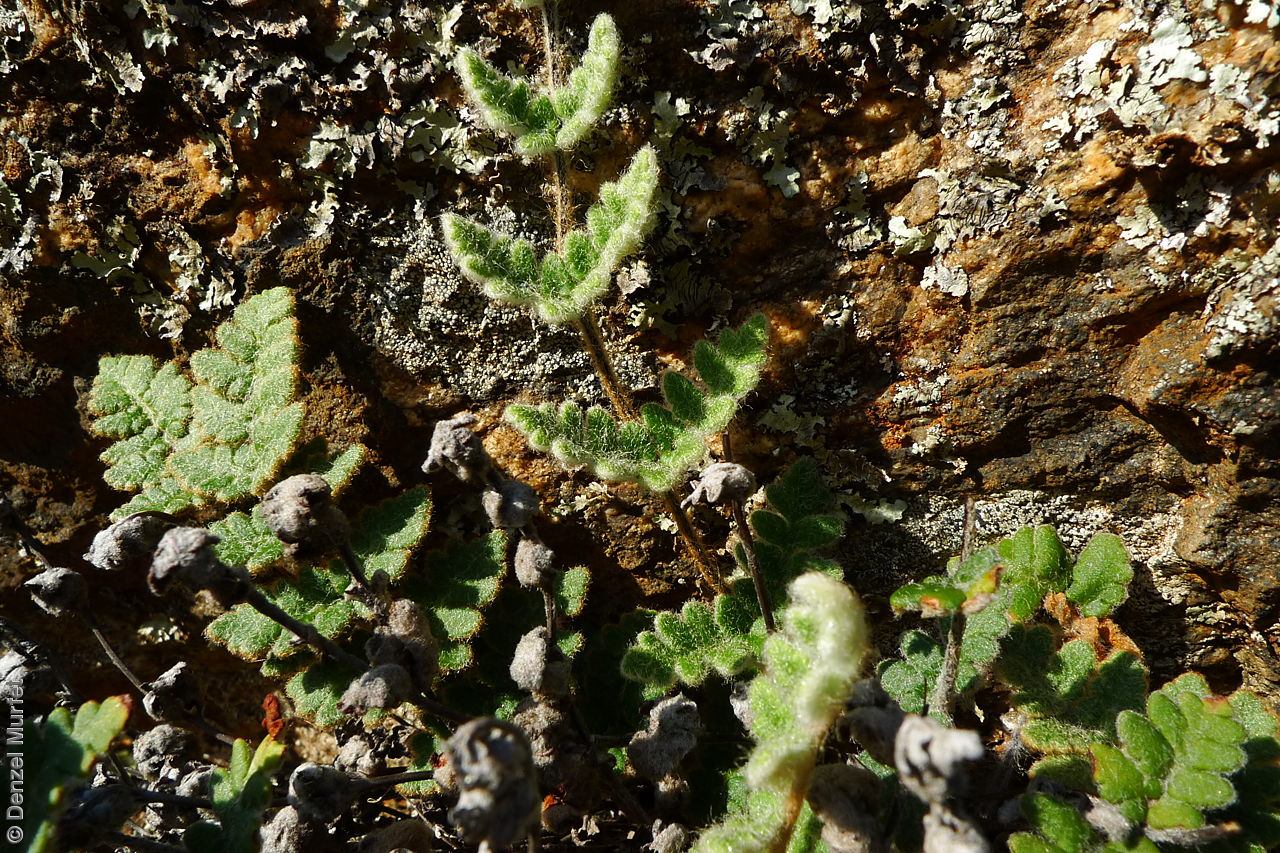Woolly Cloak-fern
Display all 5 images





Regional Species Conservation Assessments per IBRA subregion.


Least concern
Near threatened
Rare
Vulnerable
Endangered
Critically endangered
Extinct
Data deficient
Adelaide
Arkaroola
Ceduna
Coober Pedy
Hawker
Innamincka
Marla
Marree
Mount Gambier
Oodnadatta
Renmark
Wudinna
Keith
Yunta
Display IBRA region text
| Fleurieu (KAN02) | Kanmantoo | Rare (IUCN: RA d(ii)) [tolerates dry conditions] |
| Mount Lofty Ranges (FLB01) | Flinders Lofty Block | Rare (IUCN: RA d(i,ii)) [in dry gorges; a more northern sp] |
| Broughton (FLB02) | | Least Concern |
| Olary Spur (FLB03) | | Least Concern |
| Southern Flinders (FLB04) | | Least Concern |
| Northern Flinders (FLB05) | | Least Concern [common on rock faces] |
| Central Flinders (FLB06) | | Least Concern [common on rock faces] |
| St Vincent (EYB02) | Eyre Yorke Block | Least Concern |
| Eyre Hills (EYB03) | | Least Concern [rocky areas] |
| Talia (EYB04) | | Rare (IUCN: RA d(ii)) [isolated pockets, rocky areas] |
| Eyre Mallee (EYB05) | | Least Concern [rocky areas] |
| Murray Mallee (MDD02) | Murray Darling Depression | Vulnerable (IUCN: VU D1+2) [outliers] |
| Braemer (MDD07) | | Least Concern |
| Murray Scroll Belt (RIV06) | Riverina | Vulnerable (IUCN: VU D1+2) [localised] |
| Myall Plains (GAW01) | Gawler | Least Concern [rocky areas] |
| Gawler Volcanics (GAW02) | | Least Concern [rocky areas] |
| Gawler Lakes (GAW03) | | Least Concern [rocky areas] |
| Arcoona Plateau (GAW04) | | Rare (IUCN: RA d(ii)) [isolated pockets, rocky areas] |
| Kingoonya (GAW05) | | Least Concern [rocky areas] |
| Torrens (GAW06) | | Rare (IUCN: RA d(i)) |
| Roxby (GAW07) | | Rare (IUCN: RA d(ii)) |
| Commonwealth Hill (GAW08) | | Rare (IUCN: RA d(ii)) |
| Maralinga (GVD03) | Great Victoria Desert | Rare (IUCN: RA d(ii)) [isolated pockets, rocky areas] |
| Kintore (GVD04) | | Least Concern |
| Tallaringa (GVD05) | | Rare (IUCN: RA d(ii)) |
| Yellabinna (GVD06) | | Rare (IUCN: RA d(ii)) [isolated pockets, rocky areas] |
| Bimbowrie (BHC05) | Broken Hill Complex | Least Concern |
| Curnamona (BHC06) | | Least Concern |
| Breakaways (STP01) | Stony Plains | Rare (IUCN: RA d(ii)) |
| Oodnadatta (STP02) | | Rare (IUCN: RA d(ii)) |
| Murnpeowie (STP03) | | Rare (IUCN: RA d(ii)) |
| Peake-Dennison Inlier (STP04) | | Rare (IUCN: RA d(ii)) |
| Macumba (STP05) | | Rare (IUCN: RA d(ii)) |
| Witjira (STP06) | | Rare (IUCN: RA d(ii)) |
| Baltana (STP07) | | Rare (IUCN: RA d(ii)) |
| Sturt Stony Desert (CHC02) | Channel Country | Rare (IUCN: RA d(ii)) [edge of range, limited habitat] |
| Mann-Musgrave Block (CER01) | Central Ranges | Least Concern |
| Watarru (CER02) | | Least Concern |
| Everard Block (CER03) | | Least Concern |
| Tieyon (FIN03) | Finke | Rare (IUCN: RA d(ii)) |
| Fleurieu (KAN02) | Kanmantoo | Rare (IUCN: RA d(ii)) [tolerates dry conditions] |
| 6 of 6 subregions | Flinders Lofty Block | Least Concern , Rare |
| 4 of 5 subregions | Eyre Yorke Block | Least Concern , Rare |
| 2 of 6 subregions | Murray Darling Depression | Least Concern , Vulnerable |
| Murray Scroll Belt (RIV06) | Riverina | Vulnerable (IUCN: VU D1+2) [localised] |
| 8 of 8 subregions | Gawler | Least Concern , Rare |
| 4 of 4 subregions | Great Victoria Desert | Least Concern , Rare |
| 2 of 4 subregions | Broken Hill Complex | Least Concern |
| 7 of 7 subregions | Stony Plains | Rare |
| Sturt Stony Desert (CHC02) | Channel Country | Rare (IUCN: RA d(ii)) [edge of range, limited habitat] |
| 3 of 3 subregions | Central Ranges | Least Concern |
| Tieyon (FIN03) | Finke | Rare (IUCN: RA d(ii)) |
Botanical art
Kath Alcock paintings: 3
Prior names
Notholaena brownii
Etymology
Cheilanthes from the Greek 'cheilos' meaning a lip and 'anthos' meaning a flower, alluding to the lip-like indusium (thin membrane covering the sorus). Lasiophylla from the Greek 'lasios' meaning hairy or shaggy and and 'phylla' meaning a leaf; referring to the species' hairy fronds.
Distribution and status
Found across inland South Australia growing in rock crevices or on rocky slopes. Also found in all mainland States. Native. Common in South Australia. Rare in Victoria. Common in the other States.
Herbarium regions: North Western, Lake Eyre, Nullarbor, Gairdner-Torrens, Flinders Ranges, Eastern, Eyre Peninsula, Northern Lofty, Murray, Southern Lofty, Green Adelaide
NRM regions: Adelaide and Mount Lofty Ranges, Alinytjara Wilurara, Eyre Peninsula, Northern and Yorke, South Australian Arid Lands, South Australian Murray-Darling Basin
AVH map: SA distribution map (external link)
Plant description
Rhizomatous short-creeping fern covered in dense hairs. Fronds crowded, to 24 cm long and 3 cm wide. Stipe (stalk) red-brown to black, shiny, densely covered with white or golden-brown hairs. Lamina narrow-lanceolate, 2-pinnate; surface covered in dense hairs, margins lobed or entire. Fruits are sori (spores) continuous on the underside margins of the fronds between the lobes. Seeds are very fine spores.
Seed collection and propagation
Look under the fronds and collect ones with spores and place in a seal paper bags to prevent spores from fulling out. Leave fronds in the paper bag to dry. The spores will fall off naturally or give the fronds a gentle shake. Use a very fine sieve to separate any unwanted material. Be careful as the spores are very fine. Store spores in an air tight container in a cool and dry place or in a -20oC freezer.






